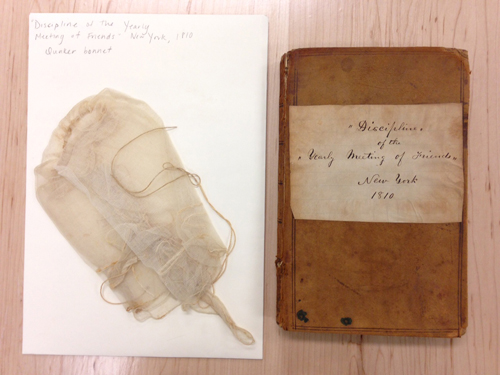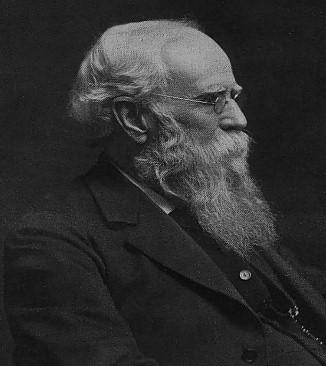Upon first glance of the spine, this little book appears fairly nondescript and boring. The book in question, “Discipline of the Yearly Meeting of Friends, Held in New York […] 1810”, printed by Samuel Wood & Sons, New York, 1826, has been digitized and is freely available on Google Books (though it is the 1836 edition). “So why bother with conservation treatment?” one might ask.
Examination of the book
After removing the book from the shelf, I found a lovely, hand-written title which had been adhered directly onto the worn leather cover. When I opened the front cover, I found a folded Quaker bonnet in reasonably good condition. Excitedly, I carefully moved it aside and read the inscription: “Geo. Merritt, 172 N. West St, Indianapolis, IN”. Next I found a note on a very old call slip that was used here at the ISL in the mid-century, indicating that this book was once in the library of THAT George Merritt, co-founder of Merritt and Coughlin Woolen Mills, Indianapolis. Merritt, who was a member of the Indiana Public School Board and the Indianapolis Parks Board, a generous philanthropist, and the man who first began improving Camp Sullivan shortly after the Civil War (later to be established formally as Military Park), was also raised as a Quaker, having migrated with his family from New York to the Midwest in the 1830s.

This book, part of the Rare Books and Manuscripts Collection at Indiana State Library, is currently in the ISL Martha E. Wright Conservation Lab awaiting treatment, after which it will be available for viewing upon request.
If this book did indeed belong to Mr. Merritt, it is no longer just a copy of “Discipline of the Yearly Meeting of Friends, Held in New York […] 1810”, it is a physical piece of his own personal history. Why was there a Quaker bonnet in the front? To whom might it have belonged? Further examination revealed printed corrections which had been adhered over original text, lines having been crossed out, loose pages inserted, and sections blanked out with blank paper (with writing in pencil on the reverse), as well as a pamphlet from an 1831 Friends Meeting. Did Merritt attend this 1831 meeting himself?
This is a prime example of why retaining and preserving original copies of books for future generations of researchers is so very important. Yes, this book has been digitized, but THIS book might have belonged to a man that played a great part in the history of Indianapolis. The book is not only a text that conveys the words inside, but an artifact that could communicate very real and tactile evidence about the life of George Merritt.
Information about George Merritt gathered primarily from Greater Indianapolis: The History, the Industries, the Institutions, and the People of a City of Homes, Volume 2, 1910 on Google Books.
This blog post was written by Rebecca Shindel, Conservator, Indiana State Library. For more information, contact the Indiana State Library at 317-232-3675 or “Ask-A-Librarian” at http://www.in.gov/library/ask.htm.

